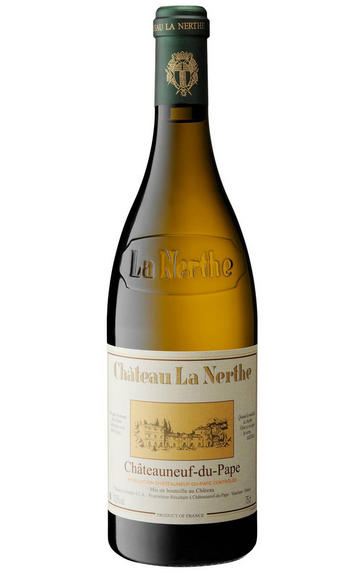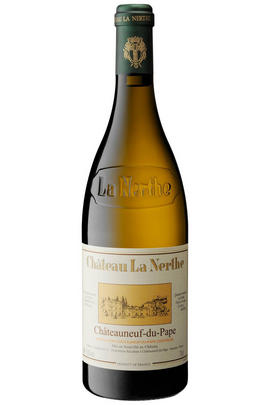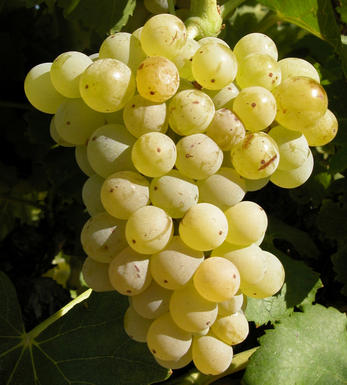
2011 Châteauneuf-du-Pape Blanc, Château La Nerthe, Rhône

Critics reviews
Readers should realize that neither the luxury cuvee, the white Chateauneuf du Pape, La Nerthe Clos de Beauvenir, not the sensational top red cuvee called Cuvee des Cadettes were produced in 2011. The seriousness of La Nerthe is evidenced by the introduction of a second wine in order to preserve the integrity and exquisite quality of their top cuvees. Their new red, the Chateauneuf du Pape Les Granieres, is primarily a blend of nearly 50% Grenache and almost equal portions of Mourvedre and Syrah, with a touch of Cinsault, aged largely in old wood foudres, but with some of the Syrah and Mourvedre components in small barrels.
Robert Parker, Wine Advocate #204, Dec 2012
Readers should realize that neither the luxury cuvee, the white Chateauneuf du Pape, La Nerthe Clos de Beauvenir, not the sensational top red cuvee called Cuvee des Cadettes were produced in 2011. The seriousness of La Nerthe is evidenced by the introduction of a second wine in order to preserve the integrity and exquisite quality of their top cuvees. Their new red, the Chateauneuf du Pape Les Granieres, is primarily a blend of nearly 50% Grenache and almost equal portions of Mourvedre and Syrah, with a touch of Cinsault, aged largely in old wood foudres, but with some of the Syrah and Mourvedre components in small barrels.
Robert Parker, Wine Advocate #204, Dec 2012
About this WINE

Chateau la Nerthe
Château la Nerthe is a stunning, 500-year-old property becoming ‘one to watch’ in recent years. Working organically since 1998, its 57 parcels on various soils and expositions produce a seamless, complex Châteauneuf-du-Pape. The care taken in both vineyard and cellar has resulted in seriously impressive wines. This property is, absolutely, a worthy rival to the likes of Château de Beaucastel. Winemaker Rémi Jean is as inspiring as the terroir – his understanding of the multiple plots and attention to detail is impressive.
Château la Nerthe’s remarkable terroir produces beautiful wines, year-in, year-out. Rocky, clay and sandy soils combined with natural springs imbue the wines with wonderful freshness and minerality. Rémi says Grenache gives his red blends “magic”, Mourvèdre brings complexity and Syrah provides structure. The very special top white cuvée, Clos de Beauvenir, comes from a single, walled plot: an old castle garden in front of the historic château.

Châteauneuf-du-Pape
The most celebrated village of the Southern Rhône, Châteauneuf-du-Pape is the birthplace of the now indispensable French Appellation d’Origine Contrôlée system – imperfect though it may be. Compared to the Northern Rhône, the vineyards here are relatively flat and often feature the iconic galet pebbles – the precise benefits of which are a source of much debate. Minimum alcohol levels required by the AOC are the highest in France, but at 12.5% it is well below the natural generosity of Grenache, which only achieves its full aromatic potential when it is fully ripe and laden with the resultant high sugars. Syrah and Mourvèdre contribute the other defining elements in the blend, adding pepper, savoury spice and structure to the decadent Grenache. There are a further 10 permitted red grape varieties which can be used to adjust the “seasoning”. Of the five white varieties permitted, it is Grenache Noir’s sibling – predictably perhaps – Grenache Blanc, which dominates, though Roussanne shows a great deal of promise when handled well, notably at Château de Beaucastel.

White Rhône Blend
With the exception of the wines from Condrieu and Château-Grillet virtually all Rhône Valley whites are made from blends.
In the north, the white wines of Hermitage, Crozes-Hermitage, St-Joseph, and St-Péray are produced from blends of Marsanne and Roussanne. Generally Marsanne is the dominant partner and it lends colour, body and weight to the blend, as well as richly scented fruit. Roussanne, a notoriously low yielder and pernickety to grow, produces intensely aromatic wines which contribute bouquet, delicacy and finesse to the blend.
Until about 15 years ago there was very little interest in southern Rhône whites as it was widely believed that the combination of dull non aromatic grapes and the baking summer heat meant quality wine production was nigh impossible. Since then the quality has improved markedly through the introduction of cool fermentation techniques and increased plantings of northern Rhône white grapes.
The base of many blends is still Grenache Blanc, a widely planted variety producing fresh wines with apple-like fruits, often with hints of aniseed. Ugni Blanc is still found in many blends, as is Clairette though their general lack of character and definition has led to a reduction in plantings. The future for southern Rhône whites appears to lie with Roussanne, Marsanne, and, increasingly, Viognier.


Buying options
Add to wishlist
Description
One of the historical, grand old properties of Chateauneuf du Pape, La Nerthe have always been famed for their whites. This is a typical blend of Grenache Blanc, Clairette and Roussanne; Apple and peach fruits, buoyed by the acidity from the Clairette.
Fergus Stewart, Private Account Manager
As with the red below, there is no top white cuvée this year. So all of the fruit normally reserved for the Beauvenir has gone into the domaine wine. The blend is Roussanne (38%), Grenache Blanc (38%) Clairette (15%) and Bourboulenc (9%). La Nerthe has always been famed for its white and now that the category is back in fashion, it still leads the pack. The Roussanne and Cairette contribute the delicious nougat and honed notes, whilst the Grenache lends gravitas and the Bourboulenc adds the zesty citrus acidity. The wine is perfect with langoustines or scallops or even a pungent cheese or two, as we found out during our last visit when we were served no fewer than 15, they all seemed to go well with the 1990 white too.
Simon Field MW, BBR Buyer
La Nerthe is by far the grandest of the Châteauneuf-du-Pape properties and now, under the guidance of oenologist Christian Voeux, it is making wines to match. Long feted by the French themselves, La Nerthe is now internationally recognised and lauded for a style which, appropriately enough seems to capture something of the structural grandeur of the greatest properties in Bordeaux.
wine at a glance
Delivery and quality guarantee